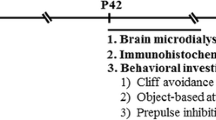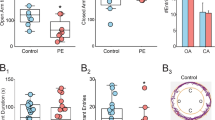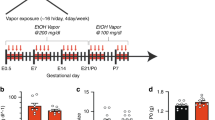Abstract
Prenatal exposure to alcohol has consistently been associated with adverse effects on neurodevelopment, which is collectively called fetal alcohol spectrum disorder (FASD). Increasing evidence suggest that prenatal exposure to alcohol increases the risk of developing attention deficit/hyperactivity disorder-like behavior in human. In this study, we investigated the behavioral effects of prenatal exposure to EtOH in offspring mice and rats focusing on hyperactivity and impulsivity. We also examined changes in dopamine transporter and MeCP2 expression, which may underlie as a key neurobiological and epigenetic determinant in FASD and hyperactive, inattentive and impulsive behaviors. Mouse or rat offspring born from dam exposed to alcohol during pregnancy (EtOH group) showed hyper locomotive activity, attention deficit and impulsivity. EtOH group also showed increased dopamine transporter and norepinephrine transporter level compared to control group in the prefrontal cortex and striatum. Prenatal exposure to EtOH also significantly decreased the expression of MeCP2 in both prefrontal cortex and striatum. These results suggest that prenatal exposure to EtOH induces hyperactive, inattentive and impulsive behaviors in rodent offspring that might be related to global epigenetic changes as well as aberration in catecholamine neurotransmitter transporter system.






Similar content being viewed by others
References
Mullally A, Cleary BJ, Barry J, Fahey TP, Murphy DJ (2011) Prevalence, predictors and perinatal outcomes of peri-conceptional alcohol exposure–retrospective cohort study in an urban obstetric population in Ireland. BMC Pregnancy Childbirth 11:27. doi:10.1186/1471-2393-11-27
Driscoll PG, Joseph F Jr, Nakamoto T (1990) Prenatal effects of maternal caffeine intake and dietary high protein on mandibular development in fetal rats. Br J Nutr 63(2):285–292
Schneider ML, Moore CF, Adkins MM (2011) The effects of prenatal alcohol exposure on behavior: rodent and primate studies. Neuropsychol Rev 21(2):186–203. doi:10.1007/s11065-011-9168-8
Eckardt MJ, File SE, Gessa GL, Grant KA, Guerri C, Hoffman PL, Kalant H, Koob GF, Li TK, Tabakoff B (1998) Effects of moderate alcohol consumption on the central nervous system. Alcohol Clin Exp Res 22(5):998–1040
Rasmussen C (2005) Executive functioning and working memory in fetal alcohol spectrum disorder. Alcohol Clin Exp Res 29(8):1359–1367
Pliszka SR (2005) The neuropsychopharmacology of attention-deficit/hyperactivity disorder. Biol Psychiatry 57(11):1385–1390. doi:10.1016/j.biopsych.2004.08.026
Pelham WE, Foster EM, Robb JA (2007) The economic impact of attention-deficit/hyperactivity disorder in children and adolescents. J Pediatr Psychol 32(6):711–727. doi:10.1093/jpepsy/jsm022
Hausknecht KA, Acheson A, Farrar AM, Kieres AK, Shen RY, Richards JB, Sabol KE (2005) Prenatal alcohol exposure causes attention deficits in male rats. Behav Neurosci 119(1):302–310. doi:10.1037/0735-7044.119.1.302
Hamilton DA, Akers KG, Rice JP, Johnson TE, Candelaria-Cook FT, Maes LI, Rosenberg M, Valenzuela CF, Savage DD (2010) Prenatal exposure to moderate levels of ethanol alters social behavior in adult rats: relationship to structural plasticity and immediate early gene expression in frontal cortex. Behav Brain Res 207(2):290–304. doi:10.1016/j.bbr.2009.10.012
Hellemans KG, Verma P, Yoon E, Yu WK, Young AH, Weinberg J (2010) Prenatal alcohol exposure and chronic mild stress differentially alter depressive- and anxiety-like behaviors in male and female offspring. Alcohol Clin Exp Res 34(4):633–645. doi:10.1111/j.1530-0277.2009.01132.x
Rathbun W, Druse MJ (1985) Dopamine, serotonin, and acid metabolites in brain regions from the developing offspring of ethanol-treated rats. J Neurochem 44(1):57–62
Cooper JD, Rudeen PK (1988) Alterations in regional catecholamine content and turnover in the male rat brain in response to in utero ethanol exposure. Alcohol Clin Exp Res 12(2):282–285
Druse MJ, Tajuddin N, Kuo A, Connerty M (1990) Effects of in utero ethanol exposure on the developing dopaminergic system in rats. J Neurosci Res 27(2):233–240. doi:10.1002/jnr.490270214
Shetty AK, Burrows RC, Phillips DE (1993) Alterations in neuronal development in the substantia nigra pars compacta following in utero ethanol exposure: immunohistochemical and Golgi studies. Neuroscience 52(2):311–322
Choong K, Shen R (2004) Prenatal ethanol exposure alters the postnatal development of the spontaneous electrical activity of dopamine neurons in the ventral tegmental area. Neuroscience 126(4):1083–1091. doi:10.1016/j.neuroscience.2004.04.041
Haycock PC (2009) Fetal alcohol spectrum disorders: the epigenetic perspective. Biol Reprod 81(4):607–617. doi:10.1095/biolreprod.108.074690
Mandrekar P (2011) Epigenetic regulation in alcoholic liver disease. World J Gastroenterol 17(20):2456–2464. doi:10.3748/wjg.v17.i20.2456
Shukla SD, Velazquez J, French SW, Lu SC, Ticku MK, Zakhari S (2008) Emerging role of epigenetics in the actions of alcohol. Alcohol Clin Exp Res 32(9):1525–1534. doi:10.1111/j.1530-0277.2008.00729.x
Zhou FC, Chen Y, Love A (2011) Cellular DNA methylation program during neurulation and its alteration by alcohol exposure. Birth Defects Res A Clin Mol Teratol 91(8):703–715. doi:10.1002/bdra.20820
Bleich S, Lenz B, Ziegenbein M, Beutler S, Frieling H, Kornhuber J, Bonsch D (2006) Epigenetic DNA hypermethylation of the HERP gene promoter induces down-regulation of its mRNA expression in patients with alcohol dependence. Alcohol Clin Exp Res 30(4):587–591. doi:10.1111/j.1530-0277.2006.00068.x
Bonsch D, Lenz B, Kornhuber J, Bleich S (2005) DNA hypermethylation of the alpha synuclein promoter in patients with alcoholism. NeuroReport 16(2):167–170
Bonsch D, Lenz B, Fiszer R, Frieling H, Kornhuber J, Bleich S (2006) Lowered DNA methyltransferase (DNMT-3b) mRNA expression is associated with genomic DNA hypermethylation in patients with chronic alcoholism. J Neural Transm 113(9):1299–1304. doi:10.1007/s00702-005-0413-2
Chen RZ, Akbarian S, Tudor M, Jaenisch R (2001) Deficiency of methyl-CpG binding protein-2 in CNS neurons results in a Rett-like phenotype in mice. Nat Genet 27(3):327–331. doi:10.1038/85906
Miyake K, Hirasawa T, Koide T, Kubota T (2012) Epigenetics in autism and other neurodevelopmental diseases. Adv Exp Med Biol 724:91–98. doi:10.1007/978-1-4614-0653-2_7
Gebicke-Haerter PJ (2012) Epigenetics of schizophrenia. Pharmacopsychiatry 45(Suppl 1):S42–S48. doi:10.1055/s-0032-1304652
Mill J, Petronis A (2008) Pre- and peri-natal environmental risks for attention-deficit hyperactivity disorder (ADHD): the potential role of epigenetic processes in mediating susceptibility. J Child Psychol Psychiatry 49(10):1020–1030. doi:10.1111/j.1469-7610.2008.01909.x
Noldus LP, Spink AJ, Tegelenbosch RA (2001) EthoVision: a versatile video tracking system for automation of behavioral experiments. Behav Res Methods Instrum Comput 33(3):398–414
Kim KC, Kim P, Go HS, Choi CS, Yang SI, Cheong JH, Shin CY, Ko KH (2011) The critical period of valproate exposure to induce autistic symptoms in Sprague-Dawley rats. Toxicol Lett 201(2):137–142. doi:10.1016/j.toxlet.2010.12.018
Katz RJ, Schmaltz K (1980) Dopaminergic involvement in attention. A novel animal model. Prog Neuro Psychopharmacol 4(6):585–590
McGaughy J, Sarter M (1998) Sustained attention performance in rats with intracortical infusions of 192 IgG-saporin-induced cortical cholinergic deafferentation: effects of physostigmine and FG 7142. Behav Neurosci 112(6):1519–1525
Kim P, Choi IH, dela Peña IC, Kim HJ, Kwon KJ, Park JH, Han SH, Ryu JH, Cheong JH, Shin CH (2012) A simple behavioral paradigm to measure impulsive behavior in an animal model of attention deficit hyperactivity disorder (ADHD) of the spontaneously hypertensive rats. Biomol Ther 20(1):125–131
Blackstone CD, Moss SJ, Martin LJ, Levey AI, Price DL, Huganir RL (1992) Biochemical characterization and localization of a non-N-methyl-D-aspartate glutamate receptor in rat brain. J Neurochem 58(3):1118–1126
Dhawan D, Ramos-Vara JA, Hahn NM, Waddell J, Olbricht GR, Zheng R, Stewart JC, Knapp DW (2012) DNMT1: An emerging target in the treatment of invasive urinary bladder cancer. Urol Oncol. doi:10.1016/j.urolonc.2012.03.015
Hughes RN (2004) The value of spontaneous alternation behavior (SAB) as a test of retention in pharmacological investigations of memory. Neurosci Biobehav Rev 28(5):497–505. doi:10.1016/j.neubiorev.2004.06.006
Barratt ES (1993) The use of anticonvulsants in aggression and violence. Psychopharmacol Bull 29(1):75–81
Bhatara V, Loudenberg R, Ellis R (2006) Association of attention deficit hyperactivity disorder and gestational alcohol exposure: an exploratory study. J Atten Disord 9(3):515–522. doi:10.1177/1087054705283880
Knopik VS, Heath AC, Jacob T, Slutske WS, Bucholz KK, Madden PA, Waldron M, Martin NG (2006) Maternal alcohol use disorder and offspring ADHD: disentangling genetic and environmental effects using a children-of-twins design. Psychol Med 36(10):1461–1471. doi:10.1017/S0033291706007884
Copp AJ, Greene ND, Murdoch JN (2003) The genetic basis of mammalian neurulation. Nat Rev Genet 4(10):784–793. doi:10.1038/nrg1181
Greene ND, Copp AJ (2009) Development of the vertebrate central nervous system: formation of the neural tube. Prenat Diagn 29(4):303–311. doi:10.1002/pd.2206
White PM, Morrison SJ, Orimoto K, Kubu CJ, Verdi JM, Anderson DJ (2001) Neural crest stem cells undergo cell-intrinsic developmental changes in sensitivity to instructive differentiation signals. Neuron 29(1):57–71
Takahashi T, Nowakowski RS, Caviness VS Jr (1996) The leaving or Q fraction of the murine cerebral proliferative epithelium: a general model of neocortical neuronogenesis. J Neurosci 16(19):6183–6196
Caviness VS Jr (1982) Neocortical histogenesis in normal and reeler mice: a developmental study based upon [3H]thymidine autoradiography. Brain Res 256(3):293–302
Goodwin DW, Schulsinger F, Hermansen L, Guze SB, Winokur G (1975) Alcoholism and the hyperactive child syndrome. J Nerv Ment Dis 160(5):349–353
Knopik VS, Sparrow EP, Madden PA, Bucholz KK, Hudziak JJ, Reich W, Slutske WS, Grant JD, McLaughlin TL, Todorov A, Todd RD, Heath AC (2005) Contributions of parental alcoholism, prenatal substance exposure, and genetic transmission to child ADHD risk: a female twin study. Psychol Med 35(5):625–635
Roizen NJ, Blondis TA, Irwin M, Rubinoff A, Kieffer J, Stein MA (1996) Psychiatric and developmental disorders in families of children with attention-deficit hyperactivity disorder. Arch Pediatr Adolesc Med 150(2):203–208
Stewart MA, DeBlois CS, Cummings C (1980) Psychiatric disorder in the parents of hyperactive boys and those with conduct disorder. J Child Psychol Psychiatry 21(4):283–292
Madras BK, Miller GM, Fischman AJ (2005) The dopamine transporter and attention-deficit/hyperactivity disorder. Biol Psychiatry 57(11):1397–1409. doi:10.1016/j.biopsych.2004.10.011
Spencer TJ, Biederman J, Madras BK, Dougherty DD, Bonab AA, Livni E, Meltzer PC, Martin J, Rauch S, Fischman AJ (2007) Further evidence of dopamine transporter dysregulation in ADHD: a controlled PET imaging study using altropane. Biol Psychiatry 62(9):1059–1061. doi:10.1016/j.biopsych.2006.12.008
Jucaite A, Fernell E, Halldin C, Forssberg H, Farde L (2005) Reduced midbrain dopamine transporter binding in male adolescents with attention-deficit/hyperactivity disorder: association between striatal dopamine markers and motor hyperactivity. Biol Psychiatry 57(3):229–238. doi:10.1016/j.biopsych.2004.11.009
Cheon KA, Ryu YH, Kim YK, Namkoong K, Kim CH, Lee JD (2003) Dopamine transporter density in the basal ganglia assessed with [123I]IPT SPET in children with attention deficit hyperactivity disorder. Eur J Nucl Med Mol Imaging 30(2):306–311. doi:10.1007/s00259-002-1047-3
Gainetdinov RR (2008) Dopamine transporter mutant mice in experimental neuropharmacology. Naunyn Schmiedebergs Arch Pharmacol 377(4–6):301–313. doi:10.1007/s00210-007-0216-0
Carboni E, Silvagni A, Valentini V, Di Chiara G (2003) Effect of amphetamine, cocaine and depolarization by high potassium on extracellular dopamine in the nucleus accumbens shell of SHR rats. An in vivo microdyalisis study. Neurosci Biobehav Rev 27(7):653–659
Heal DJ, Cheetham SC, Smith SL (2009) The neuropharmacology of ADHD drugs in vivo: insights on efficacy and safety. Neuropharmacology 57(7–8):608–618. doi:10.1016/j.neuropharm.2009.08.020
Zhu J, Reith ME (2008) Role of the dopamine transporter in the action of psychostimulants, nicotine, and other drugs of abuse. CNS Neurol Disord: Drug Targets 7(5):393–409
Szot P, White SS, Veith RC, Rasmussen DD (1999) Reduced gene expression for dopamine biosynthesis and transport in midbrain neurons of adult male rats exposed prenatally to ethanol. Alcohol Clin Exp Res 23(10):1643–1649
Barbier E, Houchi H, Warnault V, Pierrefiche O, Daoust M, Naassila M (2009) Effects of prenatal and postnatal maternal ethanol on offspring response to alcohol and psychostimulants in long evans rats. Neuroscience 161(2):427–440. doi:10.1016/j.neuroscience.2009.03.076
Riherd DN, Galindo DG, Krause LR, Mayfield RD (2008) Ethanol potentiates dopamine uptake and increases cell surface distribution of dopamine transporters expressed in SK-N-SH and HEK-293 cells. Alcohol 42(6):499–508. doi:10.1016/j.alcohol.2008.04.009
Methner DN, Mayfield RD (2010) Ethanol alters endosomal recycling of human dopamine transporters. J Biol Chem 285(14):10310–10317. doi:10.1074/jbc.M109.029561
Maiya R, Buck KJ, Harris RA, Mayfield RD (2002) Ethanol-sensitive sites on the human dopamine transporter. J Biol Chem 277(34):30724–30729. doi:10.1074/jbc.M204914200
Esler M, Eikelis N, Schlaich M, Lambert G, Alvarenga M, Kaye D, El-Osta A, Guo L, Barton D, Pier C, Brenchley C, Dawood T, Jennings G, Lambert E (2008) Human sympathetic nerve biology: parallel influences of stress and epigenetics in essential hypertension and panic disorder. Ann NY Acad Sci 1148:338–348. doi:10.1196/annals.1410.064
Esler M, Alvarenga M, Pier C, Richards J, El-Osta A, Barton D, Haikerwal D, Kaye D, Schlaich M, Guo L, Jennings G, Socratous F, Lambert G (2006) The neuronal noradrenaline transporter, anxiety and cardiovascular disease. J Psychopharmacol 20(4 Suppl):60–66. doi:10.1177/1359786806066055
Larimore JL, Chapleau CA, Kudo S, Theibert A, Percy AK, Pozzo-Miller L (2009) Bdnf overexpression in hippocampal neurons prevents dendritic atrophy caused by Rett-associated MECP2 mutations. Neurobiol Dis 34(2):199–211. doi:10.1016/j.nbd.2008.12.011
Diaz de Leon-Guerrero S, Pedraza-Alva G, Perez-Martinez L (2011) In sickness and in health: the role of methyl-CpG binding protein 2 in the central nervous system. Eur J Neurosci 33(9):1563–1574. doi:10.1111/j.1460-9568.2011.07658.x
Nagarajan RP, Hogart AR, Gwye Y, Martin MR, LaSalle JM (2006) Reduced MeCP2 expression is frequent in autism frontal cortex and correlates with aberrant MECP2 promoter methylation. Epigenetics 1(4):e1–e11
DasBanerjee T, Middleton FA, Berger DF, Lombardo JP, Sagvolden T, Faraone SV (2008) A comparison of molecular alterations in environmental and genetic rat models of ADHD: a pilot study. Am J Med Genet B Neuropsychiatr Genet 147B(8):1554–1563. doi:10.1002/ajmg.b.30877
Acknowledgments
This research was supported by research grants (09162KFDA566, 11182KFDA556) from the Korea Food & Drug Administration in 2009 and 2011.
Author information
Authors and Affiliations
Corresponding author
Additional information
Pitna Kim and Jin Hee Park are equally contributed to this work.
Rights and permissions
About this article
Cite this article
Kim, P., Park, J.H., Choi, C.S. et al. Effects of Ethanol Exposure During Early Pregnancy in Hyperactive, Inattentive and Impulsive Behaviors and MeCP2 Expression in Rodent Offspring. Neurochem Res 38, 620–631 (2013). https://doi.org/10.1007/s11064-012-0960-5
Received:
Revised:
Accepted:
Published:
Issue Date:
DOI: https://doi.org/10.1007/s11064-012-0960-5




